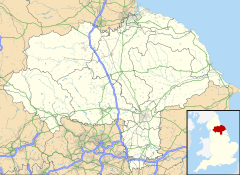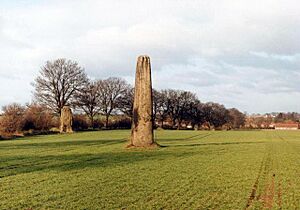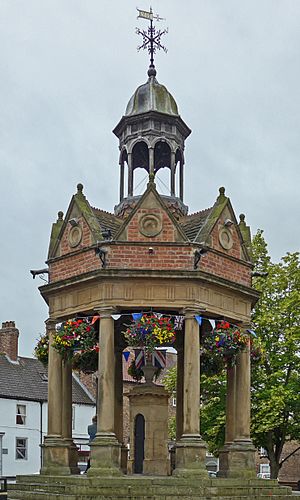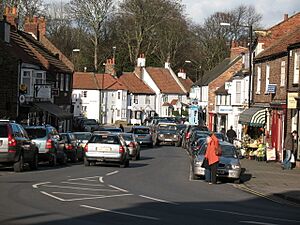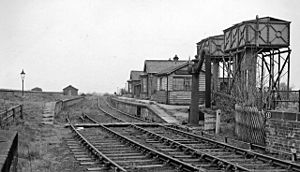Boroughbridge facts for kids
Quick facts for kids Boroughbridge |
|
|---|---|
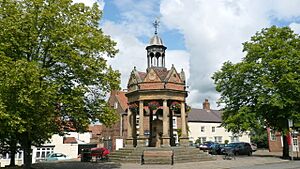 Town pump |
|
| Population | 3,405 (2011 census) |
| OS grid reference | SE393668 |
| • London | 185 mi (298 km) SSE |
| Unitary authority |
|
| Ceremonial county | |
| Region | |
| Country | England |
| Sovereign state | United Kingdom |
| Post town | YORK |
| Postcode district | YO51 |
| Dialling code | 01423 |
| Police | North Yorkshire |
| Fire | North Yorkshire |
| Ambulance | Yorkshire |
| EU Parliament | Yorkshire and the Humber |
| UK Parliament |
|
Boroughbridge is a small town and civil parish (a local area with its own council) in North Yorkshire, England. Long ago, it was part of the West Riding of Yorkshire, which was an older division of the county. The town is about 16 kilometres (10 miles) north-west of York. For many years, the main A1 road from London to Edinburgh passed right through Boroughbridge. This important road crosses the River Ure here.
The civil parish of Boroughbridge also includes the nearby villages of Aldborough and Minskip.
Contents
History of Boroughbridge
Where the Name Comes From
The name 'Boroughbridge' tells us about its location near Aldborough. Aldborough was a very important settlement during the Roman times, known as Isurium Brigantum. The Roman road called Dere Street, which went north from York, originally crossed the River Ure just north of Aldborough. Later, the road was moved to cross the river at Boroughbridge.
The name 'Boroughbridge' was first written down in 1155 in Latin as pontem de Burgo. By 1298, it was called Burghbrig in English, meaning 'the bridge near Burgh or Aldborough'. A new town grew up around this bridge, and the older settlement became known as the 'Ald-Borough' (Old Borough).
Ancient Times
On the edge of Boroughbridge, near the A1 road, you can find three very old standing stones. These stones are called the Devil's Arrows. People believe they were put there in the Bronze Age, which was thousands of years ago. The tallest stone is about 6.7 metres (22 feet) tall.
These huge stones are made of a type of rock called millstone grit. This rock probably came from a place called Plompton, which was the closest place to find it. The stones are lined up almost north to south, with the middle stone slightly out of line.
The first time these stones were mentioned was in 1694 by a fisherman named Peter Frankck. He wrote in his journal that he saw seven stones. However, an old historian named John Leyland saw four stones, which is the number we can confirm. The missing fourth stone was near the central stone. It was dug up and broken into pieces, supposedly by people looking for treasure. Most of it was used to build Peg Bridge, which crosses the River Tutt as it enters the town.
Medieval Period
Boroughbridge was not mentioned in the Domesday Book of 1086, which was a big survey of England. But it was later described as part of the Aldborough area. In 1229, Boroughbridge was given to Hubert de Burgh. However, his son lost it a few years later because he fought against the king in the Battle of Evesham in 1265. After that, Boroughbridge remained under the king's control until King Charles I gave it to some people from London.
St James' Church, Boroughbridge started as a small Norman church (a "chapel-of-ease") connected to St Andrew's Church, Aldborough. It was rebuilt in a new spot in 1852. The main Borough Bridge itself has been around since the 1100s, and the bridge you see today was built in 1562.
In 1318, Boroughbridge was badly damaged by Scottish soldiers led by Sir James Douglas. This happened after they captured Berwick upon Tweed.
A famous event, the Battle of Boroughbridge, happened in 1322. In this battle, King Edward II defeated Thomas, Earl of Lancaster. This battle ended King Edward II's revenge against those who had opposed him in a conflict called the Despenser War. A monument called the Battle Cross was put up in the market square to remember this battle. It was later moved to Aldborough in 1852.
Modern Times
From the Middle Ages, Boroughbridge was part of the Aldborough parish in the West Riding of Yorkshire. In 1553, it became a parliamentary borough. This meant it could elect two Members of Parliament (MPs) to the unreformed House of Commons (the old Parliament).
However, the right to vote in Boroughbridge was linked to owning certain properties. By the time this system was stopped in 1832, fewer than 100 people could vote. This made it a "pocket borough," meaning it was controlled by powerful families, like the Dukes of Newcastle. For example, Augustus FitzRoy, who later became Prime Minister, was elected MP for Boroughbridge in 1756, but he chose to represent another town instead.
Boroughbridge was a very important stop for stagecoaches. This was because it was located on the Great North Road, about halfway between London and Edinburgh. In 1754, an advertisement for a stagecoach service mentioned that coaches would meet at Boroughbridge on Saturday nights.
In 1866, Boroughbridge became its own separate civil parish. Later, in 1938, it grew bigger by taking in the parishes of Aldborough and Minskip.
In 1945, the bridge that carried the A1 road over the River Ure collapsed. This happened when a very heavy vehicle carrying an 80-ton steel part tried to cross it. This stopped traffic on the main road for a short time. The army had to quickly put up a temporary bridge (a Bailey bridge) until the main bridge could be fixed.
In 1974, Boroughbridge moved from the West Riding to the new county of North Yorkshire. It was part of the Borough of Harrogate from 1974 to 2023.

In 2011, the town's sewage treatment plant was updated. This plant serves about ten thousand people. Old equipment was replaced with modern screens that can filter out more waste, grit, and fat. This helps the plant work better and meet environmental rules. The tanks that clean the water were also improved to work automatically.
Governance
Boroughbridge has an electoral ward (an area for voting in local elections) with the same name. In 2011, this ward had a population of 3,104 people.
Education
Boroughbridge has both a primary school and a secondary school. Boroughbridge High School celebrated its 25th anniversary in the summer of 2007.
Media
Local news and TV shows for Boroughbridge are provided by BBC Yorkshire and BBC North East and Cumbria on BBC One, and by ITV Yorkshire and ITV Tyne Tees on ITV. TV signals come from either the Emley Moor or Bilsdale transmitters.
Local radio stations include BBC Radio York on 104.3 FM and Greatest Hits Radio Harrogate and the Yorkshire Dales on 97.2 FM.
The town's local newspaper is the Harrogate Advertiser.
Location grid
 |
Masham | Northallerton | Thirsk |  |
| Ripon | Easingwold | |||
| Harrogate | Wetherby | York |
See also
 In Spanish: Boroughbridge para niños
In Spanish: Boroughbridge para niños


